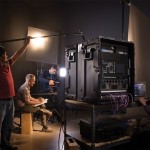The most important thing that seems to go overlooked in more workplaces is ergonomics. Ergonomic hazards can easily be avoided by using ergonomic equipment and setting up your workstation in an ideal manner. With the right ergonomic setup you have the best chances of using your abilities to their full potential.
Both employer and employee should be responsible in taking care of how their workplaces and workstations are set up to make sure that they are as ergonomic as possible. Below we’ll go over how your work desk should be set up so that it is used as ergonomically as possible. We’ll break it down into the different components including equipment, lighting and posture and go over each one individually.
Equipment
Revitalise your workspace and create the ideal working environment with ergonomic equipment which is designed to to enhance comfort and provide support.
- Keyboard – You want to place the keyboard in a position so that the wrists are straight and the hand is in line with the forearm. If your elbows are too far out from the side of the body, then you should re-adjust the height of the desk.
- Chairs – Your knees should be comfortable. If your feet do not reach the floor, then a footrest should be used. Your knees should be bent at a 90 degree angle and the chair should support your lower back.
- Phones – You shouldn’t cradle the phone with your head and shoulder. If your hands are busy, you should use a headset.
- Monitor – Your monitor should be placed within an arms length away from you; the top of the monitor should come just below your eyes.
- Desk – Your desk should easily allow for your elbows to rest at a 90 degree angle and your forearms should be parallel with the floor. Everything on your desk should also be easy to reach.
- It’s important to note that there is a lot of ergonomic equipment available on the market to improve your workspace.
Lighting
- Your monitor shouldn’t be placed directly underneath overhead lighting.
- Do keep the computer and monitor away from any windows.
- Eliminate glare and reflection by tilting the screen forwards. Use an LCD screen, cover the screen with an anti-glare surface, and use a negative contrast screen.
- If your eyes feel uncomfortable, you can turn the screen brightness down. Look away into the distance to let eyes rest, and change the text and background colours to tone this down.
Posture
There is no one position you should remain in.
- Typing posture – Avoid using only one or two fingers, this can overload the finger tendons. Avoid looking from keyboard to screen repeatedly as this can easily strain the neck, and try to tense your wrists back every so often. You can injure yourself if you are typing too fast with the incorrect form. 10,000 – 12,000 keystrokes per hour is an acceptable standard.
- Timing – Long periods of time in the same posture can result in aches and pains. Take time to stretch every so often. Employees should take time to stand and move around every so often to break out of fatigue and relax the mind.


